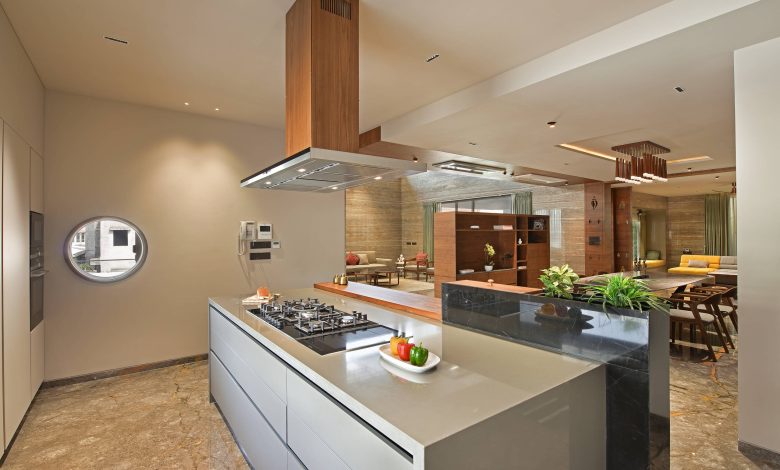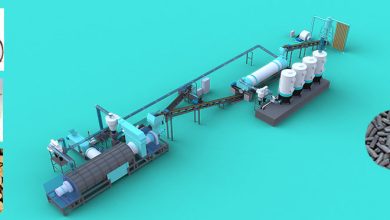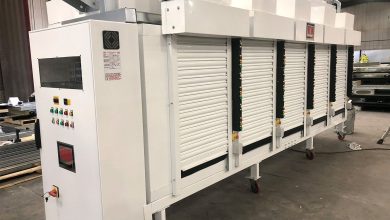Kitchen Chimney Size Calculator: Determining the Right Size for Your Kitchen

A kitchen chimney plays a vital role in maintaining a clean and odor-free cooking environment. To ensure its optimal performance, it’s important to choose the right size chimney that matches your kitchen dimensions and cooking needs. Use the following steps to calculate the appropriate size of a kitchen chimney size calculator for your space.
Step 1:
Measure your kitchen area Start by measuring the length, width, and height of your kitchen in feet. Multiply these measurements to determine the cubic footage of your kitchen. For example, if your kitchen measures 12 feet (length) x 10 feet (width) x 9 feet (height), the total cubic footage is 1080 cubic feet.
Step 2:
Calculate the chimney suction power The suction power of a kitchen chimney is measured in cubic meters per hour (m³/h). To calculate the required suction power for your kitchen, multiply the total cubic footage of your kitchen by the number of air changes per hour (ACH) recommended for your cooking habits. ACH refers to the number of times the air in the kitchen should be replaced per hour.
Kitchen Chimney Size Calculator – The recommended ACH for different cooking habits are as follows:
- Light cooking (occasional frying, boiling): 6-8 ACH
- Moderate cooking (regular frying, grilling): 10-12 ACH
- Heavy cooking (deep frying, Indian cooking with heavy oil usage): 15-20 ACH
Multiply the total cubic footage by the desired ACH range to obtain the required suction power in cubic meters per hour. For example, if you have a total cubic footage of 1080 cubic feet and you cook moderately, using an ACH of 10-12, the required suction power would be 10-12 times 1080, which is 10,800-12,960 cubic feet per hour.
Step 3:
Convert cubic feet per hour to cubic meters per hour To convert cubic feet per hour to cubic meters per hour, divide the suction power value by 35.31. This conversion factor accounts for the difference in units between cubic feet and cubic meters. For example, if the required suction power is 10,800-12,960 cubic feet per hour, the equivalent suction power in cubic meters per hour would be approximately 305-368 m³/h.
Step 4:
Choose a chimney with appropriate suction power Based on the calculated suction power, select a kitchen chimney with a suction capacity that falls within the range obtained in step 3. Consider models that provide a slightly higher suction power to ensure efficient smoke extraction and odor control in your kitchen.
It’s worth noting that these calculations provide a general guideline for determining the chimney size based on the kitchen area and cooking habits. Other factors such as the kitchen layout, presence of an island cooktop, ducting requirements, and specific chimney model specifications should also be considered when making your final selection.
Consulting the manufacturer’s guidelines and seeking advice from professionals can further assist you in choosing the most suitable kitchen chimney alternatives size for your specific needs.
FAQs about Kitchen Chimney Size Calculator
Why is it important to calculate the size of a kitchen chimney?
Calculating the size of a kitchen chimney is essential to ensure its optimal performance in terms of smoke extraction and odor control. A chimney that is too small for the kitchen may not effectively remove smoke and cooking fumes, while an oversized chimney may lead to excessive noise or unnecessary power consumption. Determining the right chimney size based on your kitchen dimensions and cooking habits helps create a comfortable and clean cooking environment.
What are the units of measurement used in the chimney size calculator?
The kitchen chimney size calculator typically uses measurements in feet for kitchen dimensions and cubic feet for the total kitchen area. The suction power of the chimney is measured in cubic meters per hour (m³/h). The conversion factor of 35.31 is used to convert cubic feet per hour to cubic meters per hour.
What are air changes per hour (ACH) and why are they important?
Air changes per hour (ACH) refers to the number of times the air in the kitchen should be replaced per hour. It is an important factor in determining the required suction power of a chimney. A higher ACH is recommended for kitchens with heavier cooking habits or strong odors, while a lower ACH is suitable for kitchens with lighter cooking activities. ACH helps ensure sufficient ventilation and efficient removal of smoke, grease, and odors.
Can I use the chimney size calculator for any kitchen layout?
The chimney size calculator provides a general guideline for determining the appropriate chimney size based on kitchen dimensions and cooking habits. However, it is important to consider other factors such as the kitchen layout, presence of an island cooktop, proximity of windows or doors, and specific chimney model specifications. For complex kitchen layouts or unique configurations, it is advisable to consult professionals or chimney manufacturers for personalized guidance.
Can I rely solely on the chimney size calculator to choose the right chimney for my kitchen?
While the chimney size calculator provides a helpful starting point, it is not the only factor to consider when choosing a kitchen chimney. Other aspects, such as the type of filter, noise level, maintenance requirements, and design preferences, should also be taken into account. Additionally, referring to manufacturer guidelines, seeking expert advice, and reading customer reviews can provide valuable insights for selecting the most suitable chimney for your kitchen.
Remember, the chimney size calculator offers a general estimation, but it’s important to consider specific requirements and consult professionals for accurate guidance tailored to your kitchen’s unique characteristics and needs.
Advantages of Kitchen Chimneys
Kitchen chimneys are an essential appliance that offers numerous benefits for homeowners. Here are some of the key advantages of using a kitchen chimney:
Smoke and Odor Extraction:
One of the primary advantages of a kitchen chimney is its ability to effectively extract smoke, fumes, and odors generated during cooking. It captures the smoke produced by frying, grilling, and other cooking methods, preventing it from spreading throughout the kitchen and other areas of the house. This helps in maintaining a fresh and clean environment while eliminating unpleasant cooking smells.
Improved Air Quality:
By removing smoke, grease particles, and other airborne pollutants, a kitchen chimney significantly improves the air quality in the cooking area. It minimizes the inhalation of harmful substances and reduces the risk of respiratory problems and allergies caused by cooking fumes. Better air quality also contributes to a healthier living environment for you and your family.
Protection of Kitchen Surfaces:
Cooking activities can lead to the accumulation of oil, grease, and soot on kitchen surfaces such as walls, cabinets, and tiles. A kitchen chimney helps prevent the deposition of these particles, reducing the need for frequent cleaning and maintenance. This advantage is particularly valuable for maintaining the aesthetics and longevity of kitchen interiors.
Reduced Heat Build-up:
The heat generated during cooking can make the kitchen uncomfortable, especially in hot climates. A chimney aids in dissipating the heat, ensuring a cooler and more comfortable cooking environment. It creates better ventilation, preventing the kitchen from becoming excessively hot and humid.
Enhanced Safety:
Cooking involves the use of open flames, hot oils, and high temperatures, which pose potential fire hazards. A kitchen chimney plays a crucial role in minimizing these risks by capturing grease and oil particles, reducing the chances of accidental fires. It helps in creating a safer cooking space for you and your family.
Easy Maintenance:
Most modern kitchen chimneys come with easily removable and washable filters. Regular cleaning of these filters helps maintain their efficiency and ensures the chimney functions optimally. Additionally, some chimneys feature auto-clean technology that simplifies the cleaning process, saving time and effort.
Aesthetically Pleasing:
Kitchen chimneys are available in a variety of stylish designs, finishes, and sizes, allowing you to choose one that complements your kitchen decor. They can serve as a decorative element, adding a touch of elegance to your cooking space.
Increased Property Value:
Installing a kitchen chimney can enhance the value of your property. Potential buyers often view a well-equipped kitchen with a chimney as a desirable feature, making it an attractive selling point if you decide to sell your home in the future.
Overall, a kitchen chimney offers numerous advantages, including effective smoke extraction, improved air quality, protection of kitchen surfaces, reduced heat build-up, enhanced safety, easy maintenance, aesthetic appeal, and increased property value. Investing in a kitchen chimney can significantly enhance your cooking experience and contribute to a healthier and more enjoyable kitchen environment.
Benefits of Kitchen Chimneys
Kitchen chimneys are an essential appliance in modern kitchens, offering a range of benefits that enhance the cooking experience and maintain a clean and healthy environment. Here are some key advantages of installing a kitchen chimney:
1. Smoke and Odor Extraction:
One of the primary benefits of a kitchen chimney is its ability to effectively extract smoke, fumes, and cooking odors from the kitchen. It captures the smoke generated during cooking and prevents it from spreading throughout the house. This eliminates the need to open windows or use exhaust fans, keeping the kitchen and the rest of your home free from lingering cooking smells.
2. Improved Air Quality:
By removing smoke, grease particles, and other airborne pollutants, a kitchen chimney significantly improves the air quality in the cooking area. It filters out harmful substances, reducing the risk of respiratory problems and allergies caused by cooking fumes. This is particularly beneficial for individuals with asthma or sensitivities to smoke and strong odors.
3. Protection of Kitchen Surfaces:
Cooking activities can lead to the deposition of oil, grease, and soot on kitchen surfaces, including walls, cabinets, and tiles. A kitchen chimney helps prevent the accumulation of these particles, reducing the need for frequent cleaning and maintenance. This advantage not only saves time and effort but also helps preserve the aesthetics and longevity of kitchen interiors.
4. Efficient Grease and Oil Capture:
Kitchen chimneys are equipped with filters, such as baffle filters or cassette filters, which effectively capture grease and oil particles. These filters prevent the accumulation of sticky residues on kitchen surfaces and appliances, reducing the risk of stains and ensuring easier cleaning and maintenance.
5. Reduced Heat and Steam:
Cooking involves the use of heat, which can create a hot and humid environment in the kitchen. A kitchen chimney helps dissipate the heat, allowing for a cooler cooking space. It also helps remove steam produced during cooking, reducing condensation on kitchen surfaces and minimizing discomfort.
6. Safety from Fire Hazards:
The presence of open flames, hot oils, and high temperatures during cooking poses potential fire hazards. A kitchen chimney aids in reducing these risks by capturing grease and oil particles, which are known to contribute to fires. By minimizing the deposition of these flammable substances, a chimney enhances kitchen safety and provides peace of mind while cooking.
7. Easy Maintenance:
Most modern kitchen chimneys come with removable and washable filters, making maintenance a hassle-free process. Regular cleaning of these filters ensures their efficiency and prolongs the lifespan of the chimney. Some chimneys also feature auto-clean technology, which simplifies the cleaning process and saves time.
8. Aesthetically Pleasing:
Kitchen chimneys are available in various designs, styles, and finishes, allowing you to choose one that complements your kitchen decor. They can serve as a stylish focal point in the kitchen, adding a touch of elegance and sophistication to the overall ambiance.
9. Energy Efficiency:
Many kitchen chimneys are designed to be energy-efficient, consuming minimal electricity while delivering optimal performance. This not only reduces energy consumption but also helps save on utility bills.
10. Increased Property Value:
Installing a kitchen chimney is considered a valuable addition to your home. It enhances the functionality and appeal of the kitchen, making it an attractive feature for potential buyers. It can contribute to increasing the overall value of your property.
In conclusion, kitchen chimneys offer a range of benefits, including smoke and odor extraction, improved air quality, protection of kitchen surfaces, efficient grease and oil capture, heat and steam reduction, enhanced safety, easy maintenance, aesthetic appeal, energy efficiency, and increased property value. By investing in a kitchen chimney, you can enjoy a cleaner, safer, and more enjoyable cooking experience while maintaining a fresh and inviting kitchen environment.
Kitchen Chimney Installation Process
Installing a kitchen chimney requires careful planning and adherence to safety guidelines. While it is recommended to seek professional assistance for chimney installation, here is a general overview of the process:
-
Pre-Installation Preparations:
- Determine the ideal location for your chimney. It should be above the cooktop or stove to effectively capture smoke and fumes.
- Ensure there is adequate space for the chimney installation, considering the dimensions of the chimney and any clearance requirements specified by the manufacturer.
- Check if there is an existing duct system in place. If not, you may need to install a ductwork system to allow for proper ventilation.
- Gather the necessary tools and equipment for installation, including screws, brackets, ducting materials, and electrical wiring components.
-
Marking and Preparation:
- Mark the desired location on the wall or ceiling for installing the chimney. Use a spirit level to ensure it is straight and aligned.
- Prepare the area by removing any obstacles or objects that may hinder the installation process.
- If required, make provisions for electrical wiring and ensure there is a nearby power source for connecting the chimney.
-
Mounting the Chimney:
- Begin by mounting the brackets or wall mount provided with the chimney. Ensure they are securely attached to the wall or ceiling, following the manufacturer’s instructions.
- Place the chimney hood onto the brackets and secure it using the provided screws. Double-check for proper alignment and stability.
-
Ducting Installation:
- If there is an existing duct system, connect the chimney to the duct using appropriate connectors or adapters. Ensure a tight and secure fit.
- If a new duct system is required, carefully measure and cut the required length of ducting material, ensuring it reaches an external vent or chimney outlet.
- Install the ducting by connecting it to the chimney outlet and the external vent or chimney cap. Use appropriate clamps or sealants to ensure an airtight connection.
-
Electrical Connections:
- If the chimney requires electrical power, consult a qualified electrician to handle the electrical connections.
- Ensure that the electrical wiring is in compliance with local electrical codes and regulations.
- Connect the chimney’s power cord to the designated power source, following the manufacturer’s instructions.
-
Final Checks and Testing:
- Double-check all connections, screws, and fittings to ensure they are secure and properly tightened.
- Switch on the chimney and test its functionality. Ensure that the fan, lights, and any other features are working correctly.
- Run the chimney for a few minutes to ensure proper air extraction and check for any unusual noises or vibrations.
- Test the chimney’s performance by cooking and observing how effectively it captures smoke and odors.
It is important to note that the installation process may vary depending on the specific model and brand of the kitchen chimney. It is always recommended to follow the manufacturer’s instructions and guidelines for the particular chimney you have purchased. Additionally, consulting a professional installer or seeking expert assistance can ensure a safe and efficient installation process.




